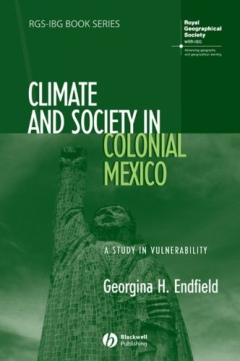Environmental historian Georgina Endfield has analyzed a wide variety of colonial archives to explore the complex relationships between climate and social and economic systems. Her book—Climate and Society in Colonial Mexico: A Study in Vulnerability—considers case studies in three distinct zones of Mexico:
- the arid Conchos Basin of Chihuahua
- the fertile Oaxaca Valley
- the agricultural area centered on Guanajuato in the Bajío region
 Endfield systematically unravels the connections between climatic vulnerability and the ways in which societies sought to mitigate the impacts of climate-related disasters, while striving for greater resilience against similar events in the future. Her book considers a range of disasters and impacts, from floods, droughts and storms to epidemics, food shortages, riots and rebellions.
Endfield systematically unravels the connections between climatic vulnerability and the ways in which societies sought to mitigate the impacts of climate-related disasters, while striving for greater resilience against similar events in the future. Her book considers a range of disasters and impacts, from floods, droughts and storms to epidemics, food shortages, riots and rebellions.
The author captures her readers immediately as she describes how “28 June 1692 was a very wet day in Celaya, Guanajuato. Unusually heavy rains began falling in the afternoon and continued all through the evening.” This was the prelude to “terrible panic among all the inhabitants of the city”, and “could not have come at a worse time”, since two years of drought and crop blights had led to famines and epidemics.
Throughout the book’s seven chapters, Endfield writes in a direct manner. She avoids lengthy quotes in favor of presenting a carefully constructed argument, as she leads the reader in an exploration of the content and merits of the colonial sources. In the final chapter, she examines the broader context, relating climatic events in Mexico to events in Europe, and considering the possible role of ENSO (El Niño Southern Oscillation) events.
An extended table towards the end of the book provides a time line for the known environmental hazard events striking the three areas between 1690 and 1820. It shows, for example, that droughts were reported in Chihuahua in no fewer than 40 years of that 130-year time span.
Referencing throughout the book is meticulous, and repeated use is made easier by the provision of a detailed index.
I do have one tiny quibble. The use of accents in this book is quite inconsistent. Even for place names, some accents are missing, while others have migrated to the wrong letter. For example, Léon is often used for León.
This is a fascinating read. Apart from the many invaluable examples of climatic hazards and their demographic, social, economic and political impacts, Endfield has been hugely successful in demonstrating the tremendous value of Mexico’s rich colonial archives, archives which no doubt still hold many more secrets, which they will only give up in response to similarly painstaking research.
Studies of climate change are set to take center-stage in coming decades, and this historical account reminds us all that climate hazards are far from a rare or a novel occurrence.
In short, this is a highly recommendable book.
Details (click for amazon.com):
Climate and Society in Colonial Mexico: A Study in Vulnerability (Blackwell, 2008) by Georgina H. Endfield; 235 pages.
Mexico’s diverse climates and climatic vulnerability are the subject of chapter 4 of Geo-Mexico: the geography and dynamics of modern Mexico. Water availability, rivers, aquifers, water issues and hazards are analyzed in chapters 6 and 7. Buy your copy today!
Sorry, the comment form is closed at this time.